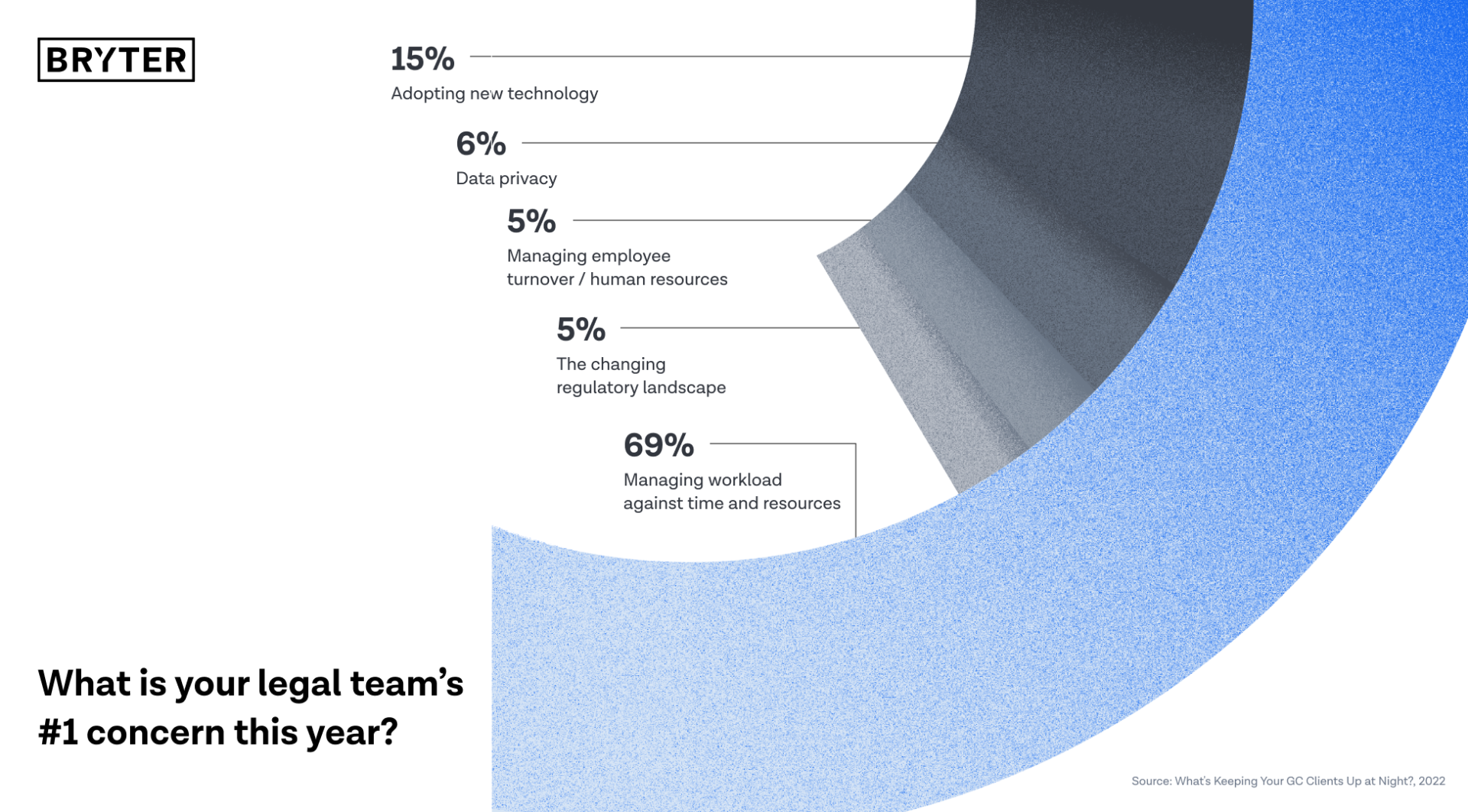Our recent survey found that 69% of GCs say their top concern is managing workload against time and resources, and they are increasingly looking for help from firms in using technology to cope. The survey also showed a rising interest in legal ops, continued struggle with repetitive low-value work, and increasing pressure from CEOs and Boards. The findings are detailed in our report What’s Keeping Your GC Clients Up at Night?
So how are firms responding to their clients’ shifting reality?
We asked leaders from some of the world’s top law firms to join us to discuss these findings, GCs’ current needs, and how firms can respond. Tara Waters, Partner and Chief Digital Officer at Ashurst; Philipp Glock, Partner and Head of Legal Corporate Services at KPMG Law; and Ben McGuire, Partner and Managing Director at Simmons & Simmons joined BRYTER CEO Michael Grupp to discuss how firms are increasingly offering legal ops and legal tech consulting, as well as bespoke digital solutions, to meet clients’ evolving needs.
Below, we recap some of the key findings of our report, and the experts’ input on what law firms must do to stay competitive in this market.
GCs’ top challenges: Managing workload and adopting new technology
69% of GCs said their top concern in 2022 was managing workload against time and resources. This comes as no surprise, as EY Law previously reported that in-house legal teams’ workload would increase 25% between 2021 and 2024, while headcount would only increase 3%.

In second place, GCs identified a challenge with adopting new technology. Philipp Glock of KPMG Law suggests these top two are related: “The demands are rising for GCs, [requiring them to be] more proactive risk managers when it comes to new topics, whether it’s supply chain issues, sanctions, or ESG. We have much more demands,” Philipp explains. “You need to find solutions for that… That’s why 15% [of GCs] say adopting new technology is a top issue, because it can be part of the answer. So it’s not surprising at all.”
Ben McGuire of Simmons & Simmons underscores how challenges have increased in the past couple of years: “There is no debating the tsunami of regulatory change, geopolitical shocks, and significant business challenges our clients are facing. On top of that, we have the pandemic and the effect on people, and changing expectations in the workplace,” Ben added. “And the one other thing that I think is coming into play increasingly is the broadening of the role of the GC from just pure business delivery of legal services into ethical and moral dimensions. So not just ‘What should we do?’ but ‘What is right?’”
So not only are GCs facing the highest-ever volume of requests, but the questions they must answer are increasingly complex, and the old ways of working simply aren’t sustainable anymore.

The top opportunities GCs see for improvement are process refinement and specialized legal tech
So how are GCs looking to solve these challenges? The top opportunities they saw to improve were in process and workflow refinement and specialized legal technology.

Tara Waters of Ashurst explains, “As we all know, starting with the solution is not the way to solve a problem. We have to get to the problem first, but ultimately, at the end of the day, there are probably going to be very few solutions that aren’t in some way a technology-enabled solution. But you do have to focus a bit on the process up front.”
Philipp Glock agreed, adding, “The whole process piece — from intake to workflow management and matter management — that’s what happens in the legal department every day. They’re being asked questions, and they need to answer those questions, but it’s not organized very well in many cases, so that’s priority one.” He elaborated on the link between process and technology, saying, “You should look at specialized legal technology, whether it’s self-servicing or document automation, but first you have to get your processes right.”
More GCs are embracing legal ops
Having a legal operations function is increasingly becoming the norm for legal departments. 62% of teams said they already have a legal ops function, up from the 54% previously reported by ACC in 2020. Another 12% are already making plans to build the function in their department soon.

Michael Grupp, CEO of BRYTER, introduced the topic by saying, “Legal operations has a root in the more tech-forward industries and now in the last five-to-seven years has been undoubtedly a top trend in many legal departments.” He then asked the panel, “When you think about helping in-house teams, do you think also about helping legal operations, having legal operations as a client?”
“It depends on the size of the company and the culture of the legal department,” Philipp Glock explained. “We’ve seen legal departments that started early on with a legal operations unit, and they do a lot of innovative things. But then there are other legal departments that are really new to this that maybe have one person in legal ops. But obviously, the topic has become a lot more popular in the last couple of years and GCs realize they need somebody to help them in-house, and I think that the funding has been provided to them within the last couple of years to get a team on board.”

Philipp went on to share how this shift impacts the way firms serve in-house clients, saying, “There’s a whole range of things that we can help them with, whether it’s insights, KPIs, benchmarking. And the outcome is really that they’ll need somebody in the future to do those operational things in-house. So in many cases, that’s actually the result of when we are done with our consulting part here.”
Ben McGuire found this data encouraging and shared, “I think [legal ops] is definitely here to stay. We’re being instructed by them and working closely with lots of them. Their authority, their integration, and their seat at the table with the GCs is increasingly becoming a trend that we’re seeing with our clients.”
Tara Waters said, “Likewise. It’s now a standard question: ‘Do you have a legal ops team?’ Plugging in directly to them is always really helpful for teams like ours, where we are focused on helping to support that service delivery within our clients’ organizations.”
What’s stopping GCs from adopting legal technology?
We have already seen that legal teams see specialized legal software as a key opportunity for improvement, so why haven’t they already adopted legal technology?
Most GCs pointed to a lack of budget for legal tech (59%) and uncertainty about which solutions were best to adopt (57%). They know that specialized software and digital processes are increasingly important to meeting the needs of the business, with only 11% saying they were happy with their current technology. However, they need help identifying the most beneficial use cases, putting together a business case for the solutions, and proving ROI to their C-suite and Board.

When asked how firms are helping their clients benefit from technology, Tara Waters shared, “It’s about actually understanding the client’s tech stack and the decision-making and investment around that. I’ve actually only spoken to one client ever that was a head of a legal team that said ‘I own my own stack. I’ve got a budget for my own stack.’ So if you’re going through traditional procurement and IT and your CIO to understand what you can invest in, it’s going to be a lot more challenging.”
She added, “There’s an element of helping the legal team with how they actually go about being able to invest in the technology itself and navigating that within the organization. Then there’s being able to advise, by really understanding the stack, on what are the things that are really going to be able to plug in and add value, especially if budgets are tight and they have a specific spend allowed for legal technology. Then you have a whole change and adoption journey to go on, and if you’re not able to do that successfully, you end up with a lot of orphaned tech.”
Ben McGuire agreed: “There’s an enormous opportunity for clients to work with organizations like the ones here on the panel, that have access to these sorts of capabilities to demonstrate significant value through the application of technology. But the key thing I think is that technology is wider than out-of-the-box products. Technology is data science; It’s people writing codes that then conduct rapid reviews. In general, I would hire legal engineers and data scientists to interact with those in our firms before I would buy [more] technology.”
Michael Grupp added, “You have a lot more success in innovative approaches with a good project manager and maybe a legal ops role. Leveraging legal technology also requires somebody to be able to do this full time and it’s a recipe for failure if you only have, say, somebody who can occasionally do it on a Thursday night. That’s not how it goes.”
And how are the law firms responding to these evolving client needs?
To wrap up the discussion, Michael Grupp posed this question to the panel. The answers present a common theme: Savvy law firms are expanding their service offering, with added tech and legal ops consulting.
Philipp Glock, KPMG Law: “What you really need to have is an A to Z legal operations offering, including the technology part. Starting with a status analysis of where they are in terms of legal operations and technology, and then really finding out where are the low-hanging fruits, whether it’s process redefinition, strategy, or their service portfolio. Then, we really go into what technologies can help. That’s what we’re doing, taking our experiences of the last couple of years especially, our best-in-class processes for operations, and adapting them to the client’s specific needs.”
Tara Waters, Ashurst: “Having a legal ops consulting offering is certainly something that a lot of law firms have added to their repertoire. More tactically, we leverage our ability to go into a client, run small experiments, do test use cases, prototype with them, and really show them the art of the possible and help inspire them to see what might work for them.”
Ben McGuire, Simmons & Simmons: “Our current philosophy is that what we need to do is assemble teams of multidisciplinary professionals who work alongside legal teams and deliver really differentiated services to solve these business problems that clients are facing. That’s across the gamut from legal operations to high-end investigations, litigations, and automating aspects of that, or helping people deal with vast quantities of data in order to answer questions from the tax man, for example. It’s the people and the capabilities that we’re investing in. The great thing about the rise of legal operations with clients is our ability to collaborate on these projects, bringing in various technologies as needed to support them.”
Helping clients solve their problems with technology
The future of legal services will be shaped by firms that not only have embraced new ways of working themselves but who can help their clients to do the same. Rather than simply accepting the need for various point solutions, it’s about showing clients how to become digital-minded, and embrace a mindset of solving challenges with technology, or as Tara Waters put it, showing them “the art of the possible.”
Looking ahead, we expect to see more firms collaborating with their clients on unique digital solutions, helping them to embrace a new, sustainable, tech-enabled reality that addresses the challenges outlined above head-on. We also expect to see firms expand upon the digital services they are already offering.
For examples of those services, read about the ones our panelist’s firms already offer, all built using BRYTER:
- Ashurst leverages automation to help clients stay “ESG Ready.”
- Simmons & Simmons launched a tool called “ESG Conquest” to guide asset managers through an assessment and provide an instant gap analysis.
- KPMG Law developed a State Aid Assessment module to assist companies in applying for economic aid.
To learn more, watch the full webinar on-demand, or download the full results of our survey. If you’re ready to explore a platform that enables bespoke digital servicing and best-in-class client collaboration, book a demo of BRYTER today.











